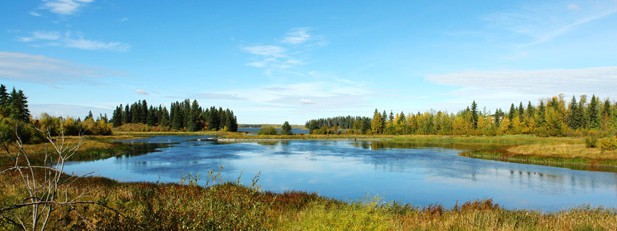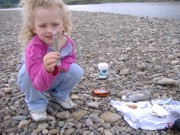What has the Backyard Wilderness project been up to? Here's a brief update on this #SAWC17 participant's current findings and future plans with her ongoing research project touching on urban wildlife. CLOSING CEREMONY: FRIDAY NOVEMBER 17th at Lethbridge City Hall!
En Garde! Protecting Riparian Zones
Backyard Wilderness: Lethbridge Backyard Trail Camera Project
Why the prairies are absolute heaven
As we pause between Christmas and the new year, many of us finally have the time to count our blessings and think about what gifts we have been given that may not have come from Santa's sled. Fix a hot chocolate and curl up with an article from OWC volunteer and Guest Blogger, Ted Naninga. He's a wildlife biologist, and new to the Lethbridge area. He explains why the Oldman watershed is the greatest gift of all. We agree! There are still two days left in 2016 if you'd like to donate. https://oldmanwatershed-council.squarespace.com/donating
Curious about the science & history in Waterton Lakes National Park?
Book The Date JULY 26th! Learn about the science and history of Waterton Lakes National Parks... topics include the threats facing salamanders, cross-boundary work on climate change, the parks’ lesser-known past and how remote cameras are used to track wildlife movement. Experts will discuss aquatic resources, landscapes, history and wildlife.
KEPA Summit 2016 - Field Tours
Pelicans, Garter Snakes and Game Boys
Editor's Note: Thanks again to wildlife photographer Rick Andrews for this guest blog postwith his stunning images! I had the privilege of having lunch with Rick recently. Our conversation quickly turned to our mutual love of the watershed - and well ... kids these days. Specifically, our own! How, we wonder, can the watershed be protected for future generations when many kids aren't given the opportunity to be out there, without electronics and understand what it means to slow down to Nature's pace - in order to be actually take notice and cherish the little things that need protection?
Pelicans and Garter Snakes text and images by Rick Andrews
The sound of a wing slap on the water startles me and I look up from my camera’s LCD screen just in time to get splashed in the face. The guilty culprits, about a dozen American White Pelicans are quickly swimming away while glancing back over their shoulders like mischievous children wanting to be chased. While I usually allow wildlife to establish their own comfort zone by approaching me, I wonder if they’re telling me I’m perhaps a bit too close, so I back up and give them a little more room, just in case.
I’m spending the morning down at the weir photographing some of my favorite wildlife subjects. People often assume that to photograph wildlife you need to go “somewhere,” but here in Lethbridge we’re fortunate, we don’t have to go anywhere, wildlife is all around us.
The weir is a small dam built by the city to create a deeper body of water, making it easier to divert river water into the water treatment plant. But like a lot of dams that have no fish ladders to aid fish swimming upstream, it traps thousands of minnows that are now easy pickings for hungry predators.
I watch the pelicans as they swim back to the edge of the weir driving the minnows into deeper water where they readily scoop them up. Yesterday I watched from the other side of the river as a group of pelicans drove minnows into shallow water. Then turning their heads and bills sideways, they scooped up the minnows with their bill pouches. Clever birds these pelicans.
But pelicans are not the only hunters here today - there are others that are neither bird nor mammal. Reptiles have come to feed on the minnows too, and the pelicans are unwittingly helping them by driving some of the minnows into the shallows.
Wandering garter snakes, a subspecies of the western terrestrial garter snake, are very skilled swimmers and hunters, and I watch as they slip silently into the water. In the shallows I can see them darting about, and it doesn’t take long before they return with a fish in their mouths.
Given their numbers today, I wonder if I’m not sitting on top of their hibernaculum, especially when I see them climb back up the river bank before disappearing into its numerous cracks and crevices all around me.
A sure sign of a healthy ecosystem!
A few days later I return, this time bringing local naturalist and snake expert Ken Moore with me. Ken tells me that wandering garter snakes can be found throughout the Oldman River valley, and though they are the least common of Alberta’s three species of garter snakes, in Lethbridge they are the most common. But its a very hot day, perhaps too hot for reptiles, and so we see only one. But that could also have something do with the red-tailed hawk we just saw sitting in a nearby tree as we approached. Along with other raptors such as osprey and owls, herons, weasels, raccoons, foxes and coyotes are all known to prey upon garter snakes too, but today its the garter snake that is the predator.
Snakes smell and hear ... like us ... only they smell through their tongues and have no ears!
I also learn that on land it finds its prey by smell together with a chemical sensory system known as the Jacobson's organ. During this process garter snakes flick their tongues, sweeping the air for scent molecules, before inserting their now scent enriched tongue tip into two tiny pits in the roof of its mouth. Once their prey species has been located, the actual attack happens very quickly.
Ken also tells me it’s doubtful this is their hibernaculum as its most likely located at least halfway up the coulee - well above the waterline. Besides, their hibernaculum is where they typically den during the winter months, then after mating in the spring, they head out, sometimes traveling as far as 25 km to spend their summers alone. Adults can grow to about a meter in length, but the one we see today is much smaller, so its perhaps a juvenile or maybe a young adult male.
Out on the water, the pelicans continue to feed and are soon joined by others that have been spending their day fishing elsewhere up river. But its getting really hot now and after making its way back up the riverbank, our garter snake disappears into one of the many crevices to cool off. Taking a cue from this little wanderer, we too wander back up the coulee before heading over to Tim’s for a little air-conditioned comfort and a nice cold Iced Capp.
Ya gotta love summer in Lethbridge.
To see more of Rick's images check out his website at www.rickandrewsphotography.com
10 Ways To Improve Your Wildlife Photography
Over the past several years I've photographed wildlife in many locations throughout the Canadian and US Rockies, as well as remote locations such as Nome Alaska and Hokkaido Japan. Along the way I've met many wildlife photographers from those just starting out to seasoned veterans. In fact since the introduction of digital cameras, wildlife photography has never been as popular as it is today, so if you are one of those people who share my passion, here are a few tips to help improve your wildlife photography and keep you safe while doing it.
You're Invited: Waterton Grizzly Film Premier May 8th
Ever wondered about your water? TEST IT!
AWQA Day, June 5th, 2015
A hands-on approach to increasing water quality awareness in Alberta
Have you ever wondered about the quality of water in your local stream or wetland?
You can have the opportunity to learn more about your local waterways by engaging in the Alberta Water Quality Awareness (AWQA) program in 2015. On June 5th we will kick-off our program for the 2015 year!
Alberta Water Quality Awareness (AWQA) aims to increase people's awareness about the health and value of water in Alberta, through hands-on water quality testing. Participants in the program are provided with a free water quality test kit.

This easy-to-use kit includes all of the materials needed to analyze four basic water quality parameters: temperature, pH, turbidity and dissolved oxygen. These basic measures of water quality have important implications for fish and wildlife habitat, outdoor recreation, and human health.
Albertans were last able to get their 'feet wet' in 2012, during Alberta's fifth AWQA event. The program was a huge success, with nearly 2000 people, from across the province, actively testing water in their communities. Families, individuals, schools, watershed groups, rural landowners, and community and youth groups all participated in the program.
Together these groups collected and tested water samples from over 200 different locations, covering all seven of the major watersheds in Alberta. These results were compiled to create a 'snapshot' of water quality in the province.
Results from past years can be viewed at www.awqa.ca

Everyone is invited to participate in AWQA 2015. Interested parties can order their free water quality test kit online at www.awqa.ca.
Kits can be ordered as a single, teacher kit package, as well as a special order for those with larger groups of students. AWQA kits will be shipped around mid-May and water quality testing can be done anytime between June 1st and August 31st. A single kit can be used ten times to test any stream, lake, river, wetland, dugout, community pond, reservoir, slough or other surface waterbody in Alberta. It is crucial to the success of this program for the data to be uploaded after collection, don't miss out on this great opportunity to get involved in the outdoors and water education.

AWQA Day is a program of the Alberta Lake Management Society in partnership with Alberta Environment and Sustainable Resource Development, and Alberta Tomorrow.AWQA Day is made possible through the generous support of our sponsor EPCOR.
For more information on Alberta Water Quality Awareness please visit www.awqa.ca.
Or contact:
info@alms.ca
(780) 415-9785
--
 |
| What my hawk looked like: A Swainson's Hawk |
 |
| This photo depicts a magpie harassing an owl, but my wounded hawk flew up to the top of the pole just like this. |
Roads, rails, pipelines, telephone wires, seismic lines ... are called "linear disturbances", and are one of the main threats to wildlife. Clearly. Many are unnecessary and some could be reclaimed if we actually made it a priority. The OWC is working on classifying linear features for just this purpose - reclamation.
Yet the plan for Alberta's countryside over the next 50 years is to populate yet more of our wild spaces, partcularly in the SW of the province. This means more people drawing wells, building roads into their properties, most tying into the grid, all driving at least 2 or more vehicles. Most people will be fleeing the cities and many will be novices regarding land stewardship.
The Buzzin' of the Bees ... and a FREE GARDEN TOUR!
Botanist, Horticulturalist and Author June Flanagan's Guest Blog

Watching the Oldman River watershed come alive with wildflowers is one of my favourite pastimes. Despite our chilly spring this year, the coulees are already dotted with yellow bells and pale purple prairie crocuses, along with petite prairie townsendia daisies and patches of tiny white moss phlox flowers. These four early-blooming native plants launch a parade of beautiful wildflowers that will continue until the first fall frost.
Anglers, ATVs, and baby fish ...
 |
| Photo courtesy Andy Hurly, Director, OWC |
Funny-lookin' thing!
Enjoy!
Andy Hurly
(Editor's note:
You will probably recognize its lovely call when you hear it in some of the videos below.
Here's an interesting science project: https://www.youtube.com/watch?v=uCs0lhF5Gmk
And here is a ton of curlew videos - some great quality, others are DIYs: https://www.youtube.com/watch?v=pNAuLaqxQ8Q&list=PLrtVlWWdpvqImwR0AUOBuklST07fVFUR2 )






























